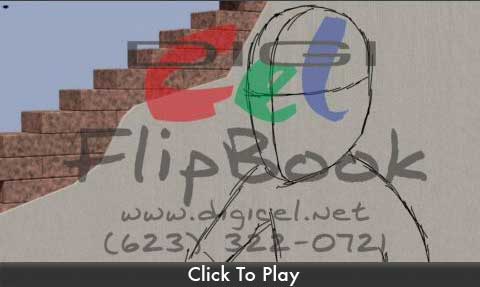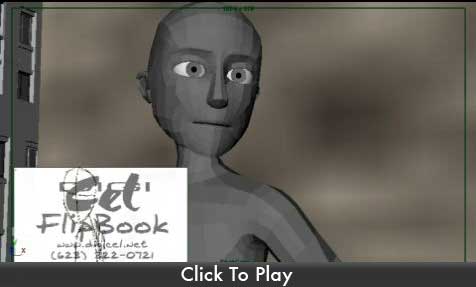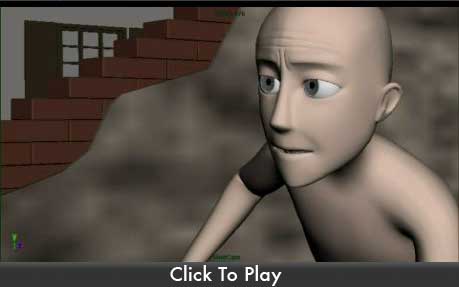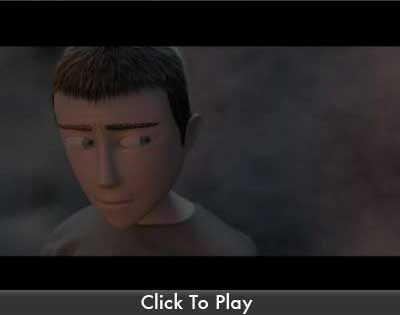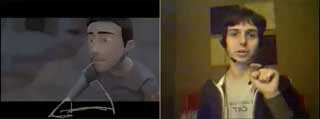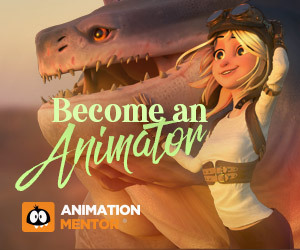Patrick Junghans
Interview conducted by Eric Scheur
I was looking through the 11 Second Club archives recently, curious if there was a pattern to be found among the people who ended up winning each monthly competition. But it turns out you just never know where a winner is going to come from. Some winners have never entered the competition before--they simply swoop in and animate better than anyone else that month. Some winners don't speak the language of the audio file as their first language. Sometimes the winning entry is in 2d, and sometimes the winner has found a way to interpret the audio in a way that had not occurred to anyone else.
This month's winner, Patrick Junghans, also defies easy categorization. He entered the July and August competitions of 2007, and then seemed to disappear for a while. At least, he didn't enter any more 11 Second Competitions. This sort of thing happens all the time: people get busy, or get jobs, begin families, or simply get tired and decide that the 11 Second Club really isn't something they have time or interest in anymore. The surprising thing, then, is that Patrick returned to the competition in September of 2008--more than a year after his last attempt--and scored very high in the rankings. One month later, he entered the competition again and BOOM! First Place!
I love seeing this kind of commitment to a craft, and it clearly has paid off very well for Patrick. I was happy to be able to talk with Patrick about his experience in being self-taught, and what it took for him to get his skill to the level where it took the prize for the 11 Second Club's October 2008 contest.
- Eric
Your website, www.maerlyn.de, has some of your previous work in other media including photography and motion graphics. Tell me about some of your earliest creations and when you knew you were really interested in pursuing a career in the visual arts.
The very first time I can recall actually doing this kind of stuff was when I was about 12, I think. Before that I can only remember doing some flipbook animations in my schoolbooks, but that probably doesn't count. My dad had this little Video8 camera and at some point I just started my first attempts in making a short film with my action figures. I even did some first tests with stop motion, but that didn't last long, because I couldn't get it to look like what I had seen on TV. So I just ended up moving them by hand and trying not to show the hands themselves. Then came little projects throughout school, but nothing too fancy, just simple camerawork and editing.
When I was 18 I got myself my first computer and was introduced to digital filmmaking. From that came more short films and then I went to study media design where I started concentrating more and more on VFX and compositing. But I wanted to tell stories with characters, so everything I did had something to do with that.
When did you become interested in character animation?
When I was a kid we used to have a TV-program called "The Sandman." It was this little fellow that would come at 6 pm on the telly and introduce a story. It was made with stop motion and I just loved it and wanted to do that, too. And then, whenever I saw things like "Thunderbirds," "The Muppet Show", "The Fraggles" or "Sesame Street" on TV, I just couldn't believe why those puppets seemed so real, so alive.
At some point during my studies I did some stop motion with a teddy bear and soon after that I tried 3D. But that was it: a trial that lasted only 3 months. But it stuck with me, even after taking a study break and starting a job as a professional compositor. I always had in mind that my next short would be animated.
A lot of what I have done until now comes into my approach to character animation. You can convey a lot about a character by just working with the camera, the editing, sounds, music, color and the mood that you build with all that. I love films where you can show a still of a scene and you can tell something about the character, his situation, his thoughts.
Being self-taught, what were some of the obstacles you encountered in discovering how to create a performance with a character?
It took me a long time to understand that without the fundamentals you cannot do character animation. I kind of jumped right into it. I think everybody wants to see his character come to life on screen, but you just can't put the carriage before the horse. It can be very frustrating; you sit down after watching an awesome animated movie, you are inspired and juiced up and you wanna do exactly that. You get your rig and all of a sudden... nothing. You just don't know what to do, really. So that's what I did, going back to basics and I am still at it, reading every day and watching all kinds of tutorials and analyzing just how they did it in the big movies. Study the basics of animation everyday and sooner or later it actually starts to get easier and more and more fun to do.
The actual character performance is a whole different ballgame. I always struggle to find out how to get just the right feeling of the character. But it's a fun struggle and challenge, and I don't think I am yet at a point where I can confidently say just how you can get here successfully. But most of the time I get at least halfway to what I had in mind.
If you could take one book and one movie (or cd, or painting, etc.) to a desert island for the rest of your life, what would they be and why?
I love reading good stories. Stephen King's classics or the world of Terry Pratchett are some of my favorites. But I think I would take a volume of "The Complete Calvin and Hobbes" with me. That stuff never gets old!
As my second piece of art I would try to sneak in some music. I can watch a movie only a few times before I get fed up. But any album of Tool ... mmmmmhhhh ... that's something I can listen to, over and over again.
Looking at your past entries, I see that you entered in September of 2008, but before that your last entry was in August of 2007--nearly a year before. I'm curious about what moved you to stop entering the competition in 2007, and then what inspired you to come back a year later?
I started working on my next short film so I kind of lost track of other things. There is not much time left when you got a full time job and you try to finish your studies. A little bit of social life wants to be maintained as well. But I did follow the competitions regularly, so I wasn't completely gone after all :o)
I came back for the same reason. The competitions are great to test your rigs in a production environment and to improve your animation and workflow.
Your October entry had a very cinematic feel to it. What was the backstory you created for yourself, and what influenced your decision to stage it this way?
Originally I was planning to go with my first idea: a snailrace. But my very wise girlfriend said to me that it was probably going to be a very common idea. I already had my scene laid out and created a snail rig, so this was kind of a pity at first. So then I listened to the audio for about one week to find an idea. It was hard because I wanted to create something funny at first and nothing came to mind. In the end I thought, why not just do it the way I actually see it.
Now I just had to find my characters. While I was killing some time with making some scene layouts I thought about who is involved in a war and most likely to respond like that. I decided for the medics because here I could incorporate somebody who has seen just a bit too much to still believe in the end of it and somebody who actually has some hope. From there on I just thought about their situation and some background stories. Mostly quite general stuff but it helped to get closer to the characters. The rest was just some tests to find the right perspective to show the story and an intro to actually get in the mood and to understand the characters better.
How have your peers helped you with this scene?
I often ask my friends and my girlfriend. Even though they don't have that much interest in the technical aspect of animation, they still love to watch it. So when something doesn't work, it's not always necessary for them to point out what exactly it is. It's enough to know that something's wrong with a certain part and then I can just pinpoint it myself. But that only works if I manage to distance myself enough.
Talk about your animation process. Do you use reference? Thumbnails?
Currently I am trying to find my way by trying out all kinds of methods. My preferred one for the moment is the one that Jason Ryan teaches in his webinars. My drawing skills really suck, but I am good enough to draw stick figures. So working with the demo of "Flipbook Pro" is just awesome once you understand how to do it.
Thumbnailing never really worked for me because I need to see the frames in relaton to each other.
I usually act out parts of the scene to the audio and draw the poses directly. I tried to film myself but it is really hard for me to synch myself up to the audio while the camera is rolling ... and I feel totally stupid as well doing it :o)
When I have problems with certain motions then I will first act it out over and over again. But if I need to see it from the distance, then I film short segments of the action and study what my body is doing.
In the 3D blocking stage I work in weird increments. First I block out each character one by one. Then I do the breakdowns, inbetweens, etc. I often switch already in this stage between the characters, especially if they are interacting. When I switch to linear/spline I do a certain segment of one character until it looks decent and then I switch to the other character. The I do the next segment of the first character and switch again. I do this until I have both characters performing in relation to each other. I do this, because it's easier to see if business has to be shifted from the back to the front and vice versa. And the shifting itself is just easier when it's still in stepped curves.
When I finally get to the facial phase I work very straight forward but always keep in mind at what point which emotion should appear. First the lipsync, then the eyes. Next come the brows and after that all the rest. This way feels more organic to me. In the October competition I actually did the sync in the middle of the process because I wanted to stage their heads more to what they say and let their thoughts guide those parts.
A lot of your performance relies heavily on solid body mechanics, which you accomplish with great subtlety. For example, the crouch-walk into the character's final standing position feels entirely natural. How do you approach animating movements like this?
At first I go into Flipbook and just try it out. If the general idea of the action doesn't support the content then I can see that really fast. Once I've decided what I will do I block out the main poses ... passings, ups, downs, contacts, turns ... all that jazz. When i go into linear/spline mode I start with the pelvis animation. Then I work with the torso. Once that looks okay I do arms and then the head. The legs usually come at last, unless I really need to see certain relations with the environment. I adapted this kind of workflow after seeing how they set up the classes at Animation Mentor. When you look at their reels you can easily see that the first thing you do is the ball, which later becomes a pelvis with legs. Then they add the arms and the head and at last comes the full rig with facial stuff. Working this way is great because it really helps to get better body mechanics.
I love the facial expression change that happens on the brown-shirtted character in the last shot. I think the shot could have been left alone without that glance back, but adding that in suggests an entirely new thought into the character's head. Where did this idea come from? Do you always look for moments like this to put into your work?
Showing thoughts to bring your characters to life is something that I got from Disney. In the "Illusion of Life" is some wonderful information on that topic and I simply try to do what they know best. The idea for this shot came from the audio. To me it sounded as if the guy with hope suddenly started to doubt himself. And having him react that way of portraying his sudden insecurity. That glance back to the "doctor" gave this just the extra oomph. It was less planning but a kind of feeling. If it had not read for me then I would have had to try something else.
What was your initial reaction to the eCritique?
It was great. I actually hoped to really get ripped apart. I felt that there was just so much that could be improved, especially if you know what those guys and gals at Pixar, Dreamworks and Co. can pull off. I sometimes even had a sneaky little thought that Brian might have been holding back a little. But all in all there was so much really great stuff in those 30 minutes. It is amazing how much one can actually go into detail. Some of the stuff that Brian talked about, would have never occurred to me.
I especially liked the fact that the pros have to fight with getting blind to the shots that they are working with. It kinda helped me accepting this as a normal thing to happen. Now I just have to find a way to freshen up my eyes from time to time.
Talk about one or two parts of the eCritique that enhanced expanded on the ideas you had originally set out to animate.
After watching the eCritique something stuck in my mind that Brian said a couple of times. When seeing this shot in a movie it "would not stick out as being wrong or out of place". And that's something I would like to get past someday. Not just being "not out of place" but actually adding something to the whole, even if it would be for a simple shot.
Looking at my entry now now I feel I could have put more business into it. Letting the characters come across much more but still keeping it simple and subtle. But there is always a next time :o)
Talk about any new concepts you were introduced to (or re-introduced to) through the eCritique.
The operative words and the stuff about the hands were really cool parts. I read Jason Osipas book "Stop Staring" a while ago and I am almost certain he also talked about operative words but I seem to have forgotten quite a bit about that. Thanks to the eCritique I will read into that again and pay more attention to it.
What Brian said about paying attention to the hands was awesome. I have to admit that I haven't really taken much care of those until now. And it's actually stupid not to do it. Hands can convey so much in terms of what the character is actually trying to bring across. If you do it right, you can really expand the display of the emotional state of the character.
Do you intend to return to this piece to incorporate the suggestions made in the eCritique?
Not really. I decided to leave it like it is and move on with all the stuff I learned. I recently read about a guy comparing digital drawing versus the traditional way with a pencil. He was talking about daring to make mistakes and learning from them by moving on to the next piece. This is supposed to keep it fun and fresh. So when I look back at this piece I will be able to remind myself what was wrong about it and what I should remember to improve.
Is there anything you'd like to add about your thought-process or experience in October's competition?
The October competition, just as the previous ones, really helped me a lot to improve. Having the 11 Seconds Club is such great opportunity if you are planning to take a swing at animation. Without this club I don't think that I would have been able to progress at such a rate. It is really important to set yourself a goal and a deadline. Without that you are in danger of losing sight of what you want and you might get fed up very soon.
So I would like to say a big thank you to everybody. Thanks to you guys for running this place and keeping it awesome! And of course thanks to Brian for his critique!
If you had to choose only one super-important lesson to pass on to a beginning animator--perhaps one that took you a long time to learn yourself--what would it be?
Be patient with yourself!
I think that is something that I only realized after a while. For instance when I read an article of Shawn Kelly about observing your environment and how after a while it becomes second nature to you. At first I tried and tried and it was really hard for me to understand just how to observe. Now, a year later, I do it every day. I will see a dog walking and actually break down the way he moves. This habit starts to be quite annyoing to people around me as well ;o)
Basically, if you wanna get into animation than simply learn from any source you can get your hands on! And in time the things that you read or watch will start to nest in your head and sooner than you might think it will show in your work.
- Patrick Junghans
Discuss this interview in the forums
comments powered by Disqus






